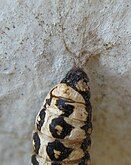Acraea horta
| Garden acraea | |
|---|---|

| |

| |
| Male imago (above) and the swarthy caterpillars on a Kiggelaria leaf | |
| Scientific classification | |
| Domain: | Eukaryota |
| Kingdom: | Animalia |
| Phylum: | Arthropoda |
| Class: | Insecta |
| Order: | Lepidoptera |
| Family: | Nymphalidae |
| Genus: | Acraea |
| Species: | A. horta
|
| Binomial name | |
| Acraea horta | |
| Synonyms | |
| |
Acraea horta or the garden acraea is a butterfly of the family Nymphalidae. It is found in South Africa and Zimbabwe.
Description
[edit]
A. horta L. (53 e, f) is one of the longest known and commonest Acraeids of the Cape, but it is also native to Pondoland, Natal, Zululand, Transvaal and Zimbabwe. It has a typical wingspan of 45–50 mm for males and 49–53 mm for females. The male is similar to that of neobule, but differs in having the black dots of the fore wing absent or only represented by a dot in the cell and another in 1b, the marginal spots of the hind wing small, elongate and incompletely separated from the ground-colour and the hindwing beneath red at the inner margin and the marginal band. In the female the forewing is almost entirely hyaline and the hindwing above light yellow to grey-yellow, beneath whitish with larger marginal spots, bounded by distinct lunules. The larva is brown-yellow with black transverse lines and yellow 7 lateral and dorsal lines, while the head and spines are black. The larva lives on Kiggelaria africana and various Passiflora species.
- female ab. conjuncta Blachier is distinguished by having the discal dots of the hindwing changed into long, broad black stripes.[3]
Biology
[edit]Adults are on wing year-round, but are more common from October to April.[4]
The larvae feed on Kiggelaria africana and Passiflora (including Passiflora coerulea, Passiflora manicata and Passiflora mollisima) and Tacsonia species.
Taxonomy
[edit]It is a member of the Acraea terpsicore species group - but see also Pierre & Bernaud, 2014 [5]
Gallery
[edit]-
The female imago
-
Eggs on underside of Kiggelaria africana leaf
-
Dorsal view of larva, showing barbed spines
-
Pupating on glass, which renders visible the spun silken mat that it grips onto
-
Ventral view: pupating on glass, showing details of its crochets which grip the silk mat
-
Pupa and larva
References
[edit]- ^ Woodhall, S.E. (2020). "Acraea horta". IUCN Red List of Threatened Species. 2020: e.T161322853A161322965. doi:10.2305/IUCN.UK.2020-1.RLTS.T161322853A161322965.en. Retrieved 18 November 2021.
- ^ Linnaeus, C. 1764. Museum Ludovicae Ulricae Reginae [viii], 1-720 + [2] pp. Holmiae.
- ^ Aurivillius, [P.O.]C. 1908-1924. In: Seitz, A. Die Großschmetterlinge der Erde Band 13: Abt. 2, Die exotischen Großschmetterlinge, Die afrikanischen Tagfalter, 1925, 613 Seiten, 80 Tafeln (The Macrolepidoptera of the World 13). Alfred Kernen Verlag, Stuttgart.
 This article incorporates text from this source, which is in the public domain.
This article incorporates text from this source, which is in the public domain.
- ^ Woodhall, Steve (2005). Field Guide to Butterflies of South Africa. Cape Town, South Africa: Struik. ISBN 978-1-86872-724-7.
- ^ Pierre & Bernau, 2014 Classification et Liste Synonymique des Taxons du Genre Acraea pdf
External links
[edit]








